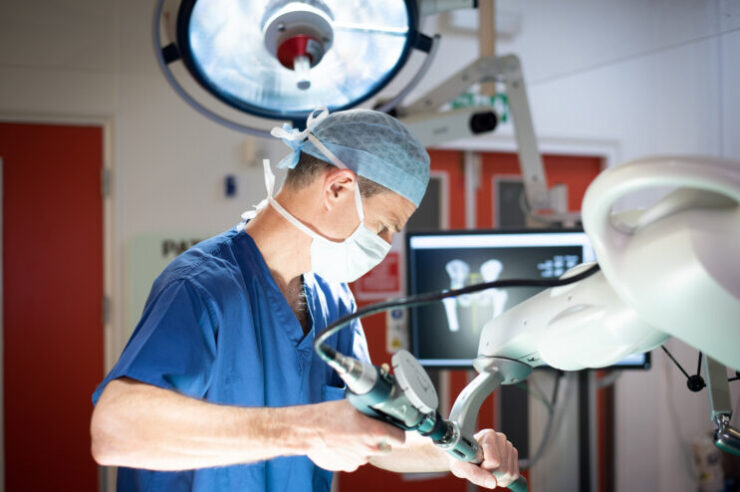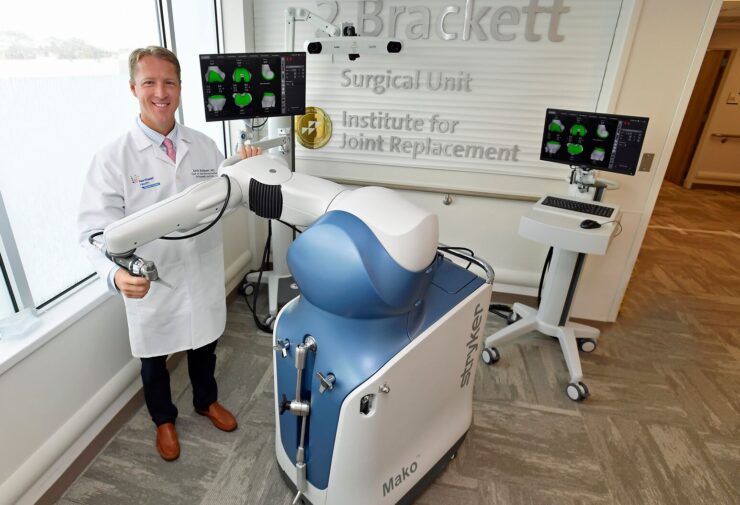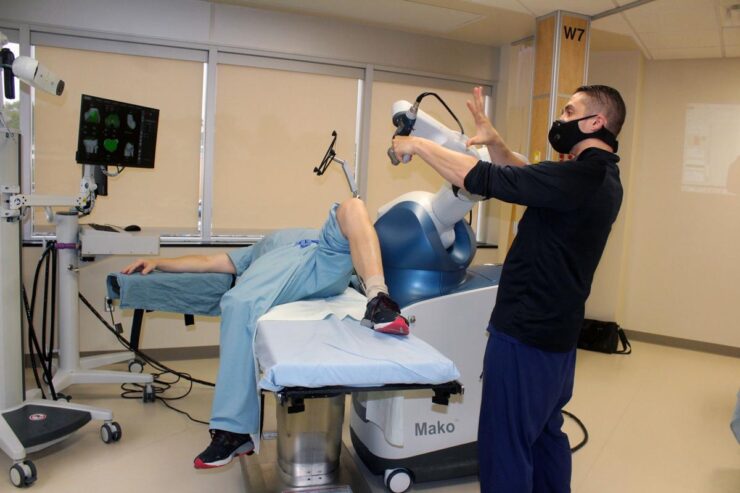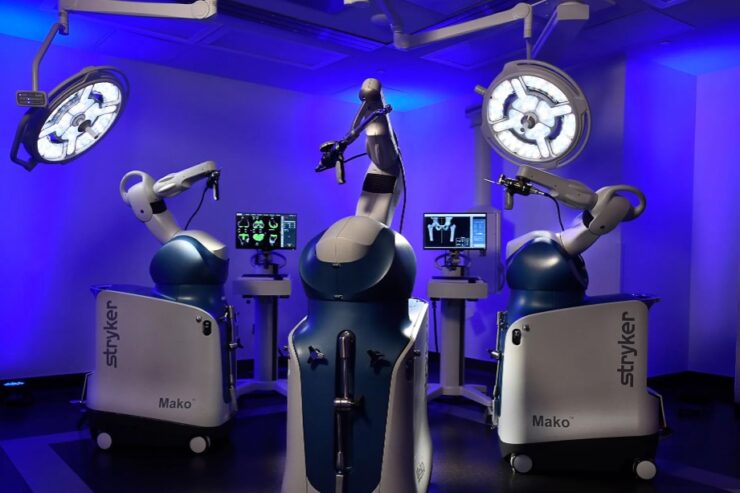The Mako Robotic-Arm Assisted Surgery is a kind of surgery that utilizes the skill and strength of robotics to augment those of surgeons. The surgical robot, typically configured as a “wristed” arm, can supplement traditional surgical instruments such as scalpels and scissors used during surgery.
This article will go through; what Mako Robotic-Arm Assisted Surgery is, the history of the robotic arm, when and why it can be used, why it should be used, and who uses it and can use it.
What is Mako Robotic-Arm Assisted Surgery?
Mako Robotic-Arm Assisted Surgery is a minimally invasive surgical procedure that uses a robotic arm to assist in the surgical procedure. The Mako robotic arm is attached to a patient-side cart and allows the surgeon to use the robot’s three-dimensional (3D) vision and dexterity to perform the surgery. With the help of the robotic arm, surgeons can have a greater range of motion and more precision when performing procedures.
The History of Robotic Arm

Surgeons have been using robots in surgery since 1985 when the first robot was used for neurosurgery. Since then, robots have been used in various surgeries, including orthopedic, cardiac, and gynecologic surgeries. In 2000, Dr. Carl Hazelrigg developed the first robotic-arm system for total knee replacement surgery. The Mako surgical robot was developed in 2001 by Dr. Craig Della Valle and was first used for hip replacement surgery in 2002.
When and Why can it be used?
It is most commonly used for joint replacement surgeries, such as hip and knee replacements. It can also be used for other types of surgeries, including:
- Spine surgeries include spinal surgeries for conditions such as scoliosis, kyphosis, and stenosis.
- ENT surgeries include surgeries on the head and neck, such as open and endoscopic skull base and sinus surgery.
- Urology- this includes surgeries on the genitourinary system of males and females, including bladder and urethra procedures.
- Gynecology includes surgery on a women’s reproductive system and pelvic surgery.
- General surgery- This includes surgeries on the organs in the abdominal cavity, such as gastrointestinal surgeries, biliary tract surgery, hepatic resection, and reconstruction of blood vessels.
Why should it be used?

There are many reasons why robotic arm assistance should be used during surgery:
- Increased Dexterity- The surgical robot has greater dexterity than traditional surgical instruments. This allows the surgeon to have finer control while performing surgery.
- 3D Vision- The robotic arm can move in three dimensions, giving the surgeon a 360-degree view of the surgical site and allowing them to perform more precise movements.
- Ability to Perform Tasks under Extreme Conditions- The robot can withstand temperatures up to 200 degrees Fahrenheit and handle other conditions that might damage or break traditional surgical instruments.
- Increased Range of Motion – The surgical robot has a greater range of motion than traditional surgical instruments. This allows the surgeon to reach difficult or awkward areas during surgery.
- Reduced Risk of Injury to Surgeon – A surgical robot reduces the risk of injury to the surgeon.
- Reduced Risk of Injury to Patient – Using a surgical robot also reduces the risk of injury to the patient.
Who Can Use it?
Mako Robotic-Arm is used by surgeons in various specialties, including orthopedic surgeons like Integrated Orthopedics, cardiac surgery, and gynecology. It can be used in any surgery where increased dexterity and precision would be beneficial.
Surgeons who have experience with robotic-arm surgery are typically better able to utilize the robot’s capabilities to the fullest extent. However, surgeons who have no prior experience with robotic surgery can successfully utilize the robot within minutes.
This type of assisted surgery has been shown to increase patient satisfaction, improve surgical outcomes, and reduce surgical costs. Because of its increased dexterity compared to traditional instruments, the surgeon is more efficient while treating the patient.
The precision abilities of the robotic arm allow for more accurate measurements of bone structures and placement of implants, leading to better surgical outcomes. Robotic arm assistance also reduces the risk of injury to both patient and surgeon by allowing surgeons full control over movements that can be very difficult or dangerous without robotic assistance.
People Who Should not Have This Procedure Done

- Those with pacemakers.
- People with implanted defibrillators, insulin pumps, or other electronic medical devices unless approved by their doctor.
- People who are pregnant or think they may be pregnant.
- Those who have an active infection in the area treated by the surgical robot should not have surgery done until the infection is resolved.
- Anyone lacking sensation or control of bodily functions in the region that will be treated by robotics during surgery should not have it performed until it can be determined that their condition has improved.
- Anyone with a blood clotting disorder.
- People with heart problems such as congestive heart failure, slow or irregular heartbeat, and high blood pressure should not have surgery unless directed by their doctor.
- People with lung problems such as emphysema, asthma, and chronic bronchitis should not have it done unless directed by their doctor.
- Those who are allergic to certain medications or materials used in the surgery.
- If you have smoked within six weeks prior to the procedure.
What Are Some Potential Complications?
Bleeding- Bleeding is a common complication associated with any surgery and can occur during or after surgery. It can be more difficult for the surgeon to stop bleeding during robotic-arm assisted surgery because incisions are made. While bleeding is an inherent risk with any surgery, it should be discussed cautiously with your doctor before surgery.
Infection- As with all surgeries, infections are a potential risk associated with this type of surgery, especially if proper sterile techniques are not utilized throughout the operative procedure. If there is an infection at the operative site or in the surgery area, it must be properly diagnosed and treated before another attempt at surgical intervention through robotics. The doctor must also address other issues such as smoking which increases the chance of infection and poor wound healing following surgery.
Organ injury- Incisions must be made near vital organs to use robotics in the surgical process. If a surgeon cuts too deep during the procedure, it can injure a nearby organ. Organ injury is a potential risk with any surgery, including Robotic-Arm Assisted Surgery. Still, it must be closely monitored by a trained medical professional to ensure the patient’s safety.
Paralysis- The robot’s arms have small instruments attached at their ends inserted into the patient’s body for direct visualization and movement where needed. Accidental damage or injury could occur during this process if not done by an experienced and talented surgeon who may result in paralysis, although rare.
Reactions- Surgeons utilizing Robotic-Arm Assisted Surgery must follow strict protocols to ensure the safety of their patients. These protocols are designed specifically for each surgical procedure to reduce the risk of any adverse reaction during surgery.
Thrombosis/embolic complications- As with all surgeries, thrombosis and embolic complications are potential problems associated with it as well. There are specific guidelines that must be followed when using robotics to prevent these risks. Still, they should be discussed with your doctor before surgery to make an informed decision about your health and wellbeing.
Injuries- Injuries can occur during robotic-arm assisted surgery if not performed by a trained medical professional who is experienced in using robotics to perform various surgical procedures. If an injury occurs, it should be fully treated and addressed by your surgeon or a member of the surgical team before you are released from the hospital.
In conclusion, robotic-arm assisted surgery is safe and effective in performing various surgical procedures. However, there are potential risks that must be discussed with your doctor before surgery to make an informed decision about your health and wellbeing. Talk to your doctor today to determine if Robotic-Arm Assisted Surgery can benefit you!

